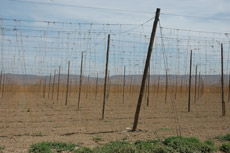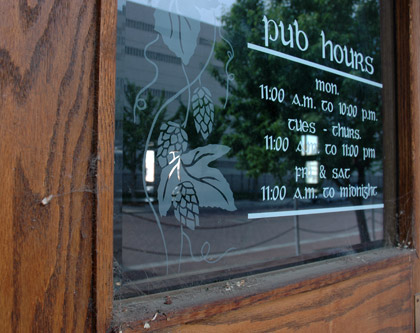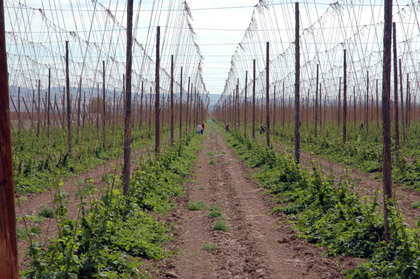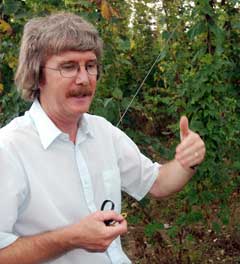 Let’s start with good news from Yakima. Here’s one of several new hopyards we saw Sunday and Monday. You can see why farmers point out it takes more than a year to make a hop field productive. Hops are well up the strings in nearby fields.
Let’s start with good news from Yakima. Here’s one of several new hopyards we saw Sunday and Monday. You can see why farmers point out it takes more than a year to make a hop field productive. Hops are well up the strings in nearby fields.
A day and a half driving through one of the world’s premier hop-growing regions was a mixed bag. We saw plenty of hop memories — vacant buildings where hop merchants once did business, a hop kiln you can spot from the Interstate, and of course the American Hop Museum in Toppenish.
It was also evident that wine is a much stronger tourist attraction. Interstate exit signs advertise stops with wineries, and we’re talking scores of choices. The banners in downtown Yakima remind visitors this is Washington Wine Country. Many of the tasting rooms were jammed during the Memorial Day weekend, while we were the only visitors at the Hop Museum.
Daria and Sierra have both written about that experience, disappointing from the moment we walked through the door covered with plywood. It felt like the beginning of a museum when I visited in 1997, but nothing appears to have been done since. Including maintenance. It made me think I really need to take them the German Museum of Hops (Deutsches Hopfenmuseum) in Bavaria this fall so they’ll see a hop museum done right.
Quite simply, this one does not reflect the love of hops that American brewers expend in creating beers that celebrate American hops. Perhaps we need to put a tax on Simcoe and Amarillo hops to pay for some upkeep — and that way those hop varieties might merit a mention somewhere within its walls.

As appropriate as it turned out that America’s first brewpub, variously known as Grant’s Brewery Pub and Yakima Brewing and Malting, opened in hop country it should be sobering that starting in Yakima you can now visit scores of wineries before you find the first brewing operation (Snipes Mountain in Sunnyside). Grant’s, housed in the old downtown train station, still looks great from a distance. Hops are etched in the glass doors leading into the pub, along with the hours. But the only thing inside is the old wooden bar, and cobwebs hang around the windows.
Fortunately we headed from there to Moxee. Amarillo and Simcoe are grown here. Don’t you wonder what Bert Grant would have done with those hops? Here there are more hopyards than vineyards, but as across all the rolling hills of Yakima Valley more fruit trees than anything. Also plenty of sheep, goats, cattle — we later visited a cheese factory that can process a half million gallons of milk a day — and horses. (Apparently the Yakima Valley is a top pot producer as well.)

Although it was Memorial Day, we spotted several crews at work in the hopyards, a quick reminder that hops are downright labor intensive as far as agricultural products go.
Worth appreciating.
A note from Yakima Sportsman’s Park: I plan to continue with Monday musings throughout our journey, but there are times I’ll be writing on Monday and not posting until I find the next Internet connection.
 Mark Dredge has an excellent post on a couple of English hop varieties that were once rejected — so officially, I guess, they never became varieties — that now may get fully developed.
Mark Dredge has an excellent post on a couple of English hop varieties that were once rejected — so officially, I guess, they never became varieties — that now may get fully developed.  Let’s start with good news from Yakima. Here’s one of several new hopyards we saw Sunday and Monday. You can see why farmers point out it takes more than a year to make a hop field productive. Hops are well up the strings in nearby fields.
Let’s start with good news from Yakima. Here’s one of several new hopyards we saw Sunday and Monday. You can see why farmers point out it takes more than a year to make a hop field productive. Hops are well up the strings in nearby fields.
